The key to extracting valuable information, insights, feedback, and opinions through your customer surveys lies in the art of crafting well-designed questions. Survey questions play a crucial role in the success of your surveys.
When it comes to creating effective survey questions, you come across a range of question types of use in your surveys. Understanding these diverse question types is the first step to creating effective surveys and fetching meaningful results through them.
In this article, we will explore various types of survey questions with some survey question examples & pro-tips, how to create them, and some best practices to craft effective questions for your surveys. Let’s get started!
TL;DR
-
Survey questions play a crucial role in extracting valuable information, insights, and feedback from customer surveys, making the art of crafting well-designed questions essential for survey success.
-
Understanding diverse survey question types is the first step to creating effective surveys and obtaining meaningful results. There are various types of survey questions to include in your surveys - Rating Survey Questions, Dichotomous Questions, Likert Scale Survey Questions, Open-ended Survey Questions, Closed-ended Survey Questions, and more.
-
For creating different types of survey questions, you should follow these steps - define your objectives, choose the right question format, mix closed-ended and open-ended questions, tailor questions as per your target audience and survey objectives, and pilot test your survey before sending the final survey.
-
While creating your survey questions, you should also follow some best practices - define clear objectives, understand the audience, use clear language, avoid double-barreled questions, provide balanced response options, consider question order, include a mix of question types for comprehensive data collection, and use a good compatible tool to create surveys.
-
Zonka Feedback is an effective survey software equipped with compatibility for various question types, templates, and advanced features like survey logic and question branching, facilitating effective surveys and valuable feedback collection from customers. It also offers a free trial for 14 days.
Build and send a survey today 🔥
Choose from over 40+ question types, add your own themes and create amazing surveys that people love answering.

Types of Survey Questions
Here are the different types of survey questions that you can consider including in your surveys to collect meaningful responses from your survey audience.
1. Rating Scale Questions
Rating questions are one of the most common types of survey questions used in surveys, In these questions, the respondents are given a choice to assign a value or score to a particular statement, product, service, aspect, or experience. A rating scale is provided to the respondents to choose their survey responses.
Rating scales may vary depending upon your survey requirements like a 10-point rating scale for a 1 to 10 opinion scale survey, an 11-point rating scale for an NPS survey, a 5-point rating scale for a CSAT survey, a 7-point rating scale for a CES survey and more.
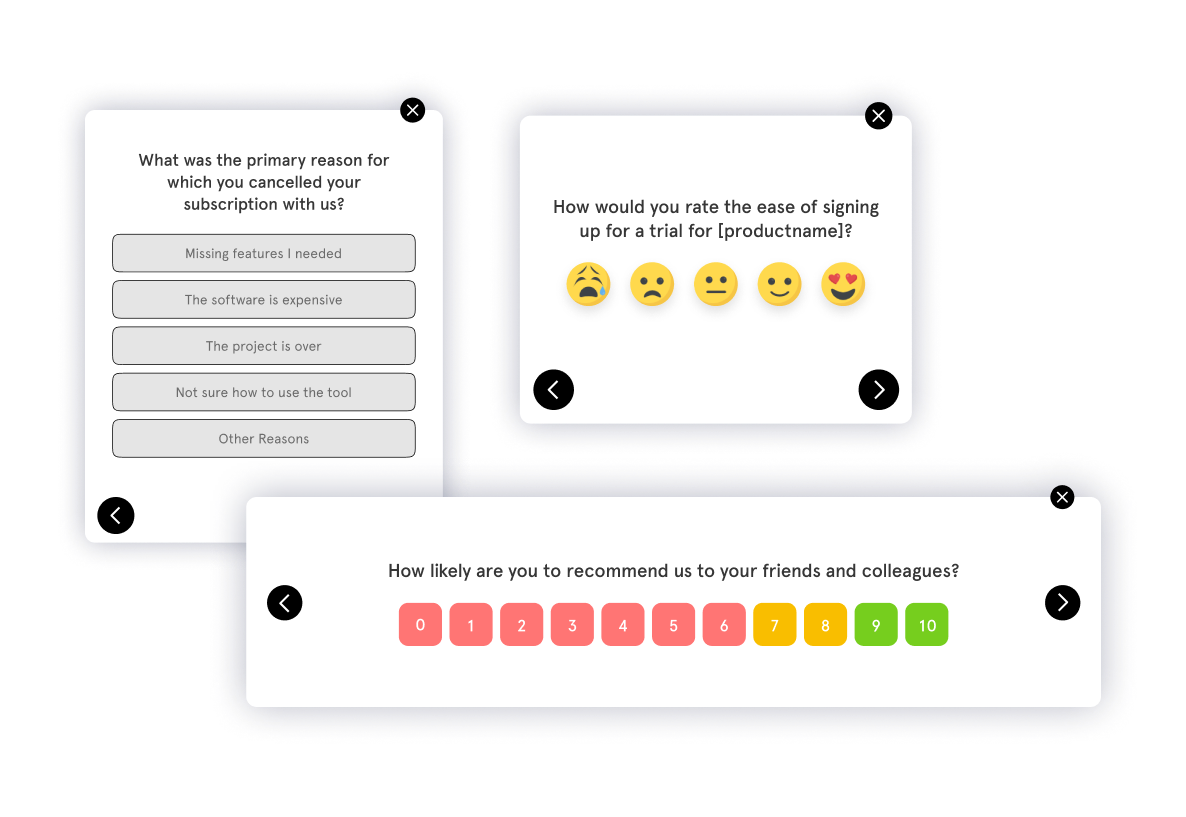 Rating survey questions can be bipolar or unipolar
Rating survey questions can be bipolar or unipolar
-
In Unipolar rating scales, respondents express their opinions or attitudes using a scale that consists only of positive values. For example, a satisfaction scale may range from "Not at all Satisfied" to "Extremely Satisfied," allowing participants to indicate the extent of their positive sentiments.
-
Bipolar rating scales encompass both positive and negative values, offering respondents a broader spectrum for expressing their opinions. An example could be rating scale surveys with a scale ranging from "Strongly Disagree" to "Strongly Agree," allowing participants to indicate the degree of agreement or disagreement with a statement.
Examples
-
On a scale of 1 to 5, how satisfied are you with your recent purchase?
-
Please rate the overall organization of the event on a scale from poor to excellent.
Tips from Experts
-
Clarity is Key: Ensure that the rating scale is clearly defined, whether numerical or labelled (e.g., from "Very Dissatisfied" to "Very Satisfied"). This clarity enhances the reliability of collected data.
-
Balanced Scaling: Use a balanced scale to avoid skewing results. Including both positive and negative options provides a more accurate representation of participant sentiments.
-
Consider Context: Tailor the rating scale to the context of the question. For instance, a scale of 1 to 10 might be suitable for measuring satisfaction, while a simpler 3-point scale could suffice for a yes/no/maybe scenario.
2. Dichotomous question
A dichotomous question is a type of survey inquiry that presents two mutually exclusive options, often in a "yes" or "no" format. The term "dichotomous" refers to the division of choices into two distinct and opposing categories. These questions are straightforward, requiring respondents to choose between two clear and exhaustive alternatives, making them particularly useful for collecting binary or categorical data.
Surveys like Thumbs up/down surveys and Yes/No surveys are examples of surveys that typically contain dichotomous questions. Here are some examples of dichotomous questions.

Examples
-
Have you ever purchased a product from our company?
-
Yes
-
No
-
-
Did you find the information provided helpful?
-
Yes
-
No
-
-
Are you interested in receiving promotional emails?
-
Yes
-
No
-
Tips from Experts
-
Clarity is Crucial: Ensure that the options are clearly defined, leaving no room for ambiguity. Ambiguous questions may lead to confusion and inaccurate responses.
-
Use for Specific Information: Dichotomous questions are most effective when seeking specific, binary information. They are ideal for situations where a simple yes/no response provides valuable insights.
-
Avoid Double-Barreled Questions: Refrain from combining multiple ideas or concepts within one question. Keep dichotomous questions focused on a single, clear topic to maintain respondent clarity.
-
Consider Response Bias: Be aware that dichotomous questions may introduce response bias due to the limited options. Respondents may feel compelled to choose one option even if their true feelings are more nuanced.
-
Strategic Placement: Place dichotomous questions strategically within the survey to maintain respondent engagement. They are often useful for starting or concluding a survey section, providing quick and straightforward input.
3. Likert scale survey questions
Likert scale questions are those which help you measure the degree of agreement or disagreement with a statement, presenting respondents with a range of response options. The Likert scale typically consists of a series of statements or items accompanied by a scale of choices, such as "Strongly Disagree," "Disagree," "Neutral," "Agree," and "Strongly Agree." To answer questions, respondents select the option that best reflects their opinion or sentiment toward each statement.
Likert scale questions provide a structured and quantifiable method for gauging attitudes, perceptions, or preferences, making Likert scale surveys to be widely used in research, customer feedback, and opinion surveys.
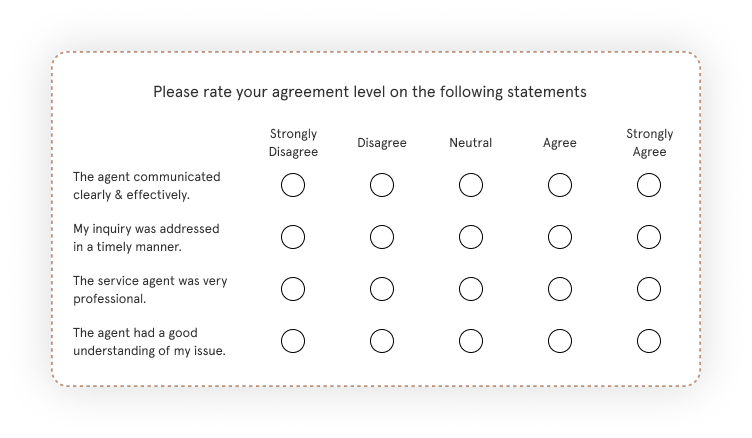 Examples
Examples
-
Please indicate your level of agreement with the statement: 'The website navigation is user-friendly.'
-
Strongly Disagree
-
Disagree
-
Neutral
-
Agree
-
Strongly Agree
-
-
Rate your satisfaction with the customer service received
-
Very Dissatisfied
-
Dissatisfied
-
Neutral
-
Satisfied
-
Very Satisfied
-
Tips from Experts
-
Balance Positive and Negative Statements: Include a mix of positively and negatively framed statements to mitigate response bias and ensure a well-rounded assessment.
-
Use a Neutral Midpoint Judiciously: Reserve the "Neutral" or "Neither Agree nor Disagree" option for situations where respondents genuinely feel ambivalent, avoiding its overuse as a default response.
-
Keep Statements Clear and Concise: Formulate statements that are easily understandable to minimize interpretation variability among respondents.
-
Mindful Scaling: Determine the appropriate scale range (e.g., 5-point, 7-point) based on the desired granularity of responses while balancing it with respondent comfort and survey length.
4. Open-ended survey questions
Open-ended questions are those that allow respondents to provide unrestricted, qualitative responses in their own words. Unlike closed-ended questions with predefined answer options, open-ended questions prompt participants to express their thoughts, opinions, or experiences freely.
Open-ended questions are valuable for obtaining rich, in-depth insights, exploring nuances, and uncovering perspectives in customers' own words to understand the exact customer insights that may not be captured through predefined choices.
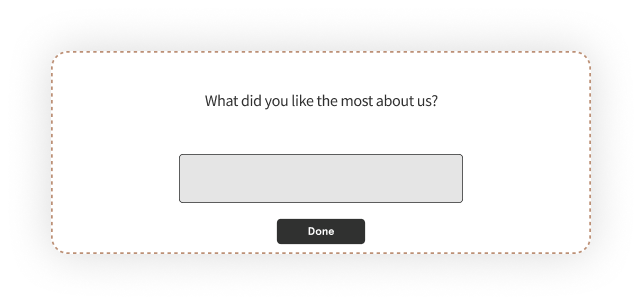 Examples
Examples
-
What suggestions do you have for improving our product or service?
-
Describe your experience with our customer support team.
-
How would you prioritize the features you'd like to see in our next product?
Tips from Experts
-
Be Specific and Clear: Craft open-ended questions with clarity and specificity to guide respondents and ensure relevant and focused responses.
-
Encourage Elaboration: Frame questions in a way that encourages respondents to elaborate on their answers, providing more detailed and insightful information.
-
Avoid Leading Language: Steer clear of leading questions or biased language that might influence respondents. Maintain neutrality to allow for unbiased and authentic responses.
-
Use at Strategic Points: Integrate open-ended questions strategically within a survey, balancing them with closed-ended questions. This approach combines quantitative and qualitative data for a comprehensive analysis.
-
Analyze Thoughtfully: Analyzing open-ended responses can be time-consuming, but it offers a wealth of qualitative data. Use coding or thematic analysis to derive patterns and themes from the varied responses.
5. Closed-ended survey questions
Closed-ended survey questions are those which provide respondents with predetermined response options, limiting their choices to a set list. Unlike open-ended questions that allow free-form qualitative responses, closed-ended questions offer respondents a finite selection of answer options.
This format is particularly useful for gathering quantitative data and streamlining the analysis process, as responses can be easily categorized and measured. Closed-ended questions often include options like multiple-choice, Likert scales, dichotomous (yes/no), or rating scales.
 Examples
Examples
-
Which of the following products have you purchased?
-
Product A
-
Product B
-
None
-
-
On a scale of 1 to 5, how satisfied are you with our services?
-
Do you agree or disagree with the statement: 'The website is easy to navigate'?
Tips from Experts
-
Provide Exhaustive Options: Ensure that the list of response options is comprehensive and covers all potential choices to avoid ambiguity and capture a wide range of opinions.
-
Mindful Sequencing: Arrange response options logically and thoughtfully. Consider starting with straightforward or less sensitive questions before delving into more complex or sensitive topics.
-
Avoid Double-Barreled Questions: Each survey question should focus on a single idea or concept. Avoid combining multiple thoughts in one survey question to prevent confusion and ensure clarity.
-
Balance Scales: When using Likert scales or rating systems, aim for a balanced distribution of positive and negative statements to reduce bias and encourage honest responses.
-
Pilot Testing: Before widespread use, conduct pilot testing to identify any issues with question-wording, response options, or clarity. This helps refine closed-ended questions for optimal effectiveness.
6. Ordinal Scale Question
Ordinal scale questions are a type of survey inquiry that requires respondents to rank or order items based on their preferences, opinions, or characteristics. Unlike interval or ratio scales that provide precise measurement intervals, ordinal scales focus on establishing the relative order of items without implying specific differences between them.
These questions are effective when assessing preferences, priorities, or perceptions where the order of items matters more than the exact magnitude of the differences.
Examples
- Please rank the following smartphone features in order of importance
- Camera
- Battery Life
- Storage Capacity
- Indicate your preference for the following vacation destinations
- Beach
- Mountains
- City
Tips from Experts
-
Use Clear Instructions: Provide explicit instructions on how respondents should rank or order the items to ensure consistency in their interpretations.
-
Limit the Number of Items: To maintain respondent engagement and prevent fatigue, avoid presenting an excessive number of items for ranking.
-
Understand the Relative Order: Emphasize that respondents should consider relative importance or preference when ranking items rather than assigning absolute values.
-
Consistent Scaling: Keep the scaling consistent across all items being ranked. If using numbers, ensure that respondents understand the meaning behind each rank.
7. Dropdown questions
Dropdown questions are a type of closed-ended survey question format that presents respondents with a list of predefined options in a dropdown menu. Instead of displaying all options simultaneously, respondents can click on the dropdown menu to view and select their answers from the available choices.
Dropdown questions are useful when you have a relatively long list of response options or when you want to conserve space on the survey form. They are also helpful when you want to ask demographic questions from your customers to understand them better.
Examples
- Choose your age group: [Dropdown menu with options like 12-17, 18-25, 25-35, 35-40, 40-60, 60-70, 70 above]
- Choose your preferred mode of transportation: [Dropdown menu with options like Car, Bus, Train, Bicycle]
- Choose your favorite genre of music: [Dropdown menu with options like Pop, Rock, Jazz, Hip Hop]
Tips from Experts
-
Keep Options Relevant: Ensure that the response options in the dropdown menu are relevant to the survey question and cover the entire range of possible answers.
-
Limit the Number of Options: While dropdowns are useful for condensing long lists, be cautious not to overwhelm respondents. Limit the number of options to maintain clarity and ease of selection.
-
Alphabetical Order: Arrange response options in alphabetical order within the dropdown menu to simplify navigation for respondents.
-
Include an 'Other' Option: If there's a possibility that respondents might have an answer not covered by the predefined options, consider including an "Other" option to capture diverse responses.
-
Choose a Compatible survey tool: Ensure that the survey software or app you are using supports dropdown functionality and that it works seamlessly across different devices to provide a positive user experience.
8. Multiple-Choice Questions
Multiple-choice questions (MCQs) are a common type of closed-ended survey question format that presents respondents with a list of predefined answer options, and they are instructed to choose one or multiple answers that apply. Each option typically corresponds to a possible response or solution, and respondents select the ones that align with their preferences, opinions, or experiences.
Multiple-choice questions are versatile and can be used to gather quantitative data efficiently. 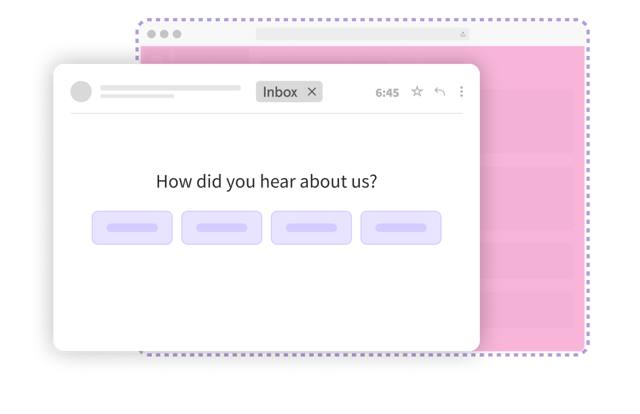
Examples
-
Which of the following social media platforms do you use regularly? (Select all that apply)
-
Facebook
-
Twitter
-
Instagram
-
All of the Above
-
None of the Above
-
-
What factors influenced your purchase decision? (Select one)
-
Price
-
Product Reviews
-
Brand Reputation
-
Other
-
Tips from Experts
-
Clearly Define Instructions: Clearly instruct respondents on how many choices they can select (e.g., "Select all that apply" or "Choose one option").
-
Avoid Overlapping Choices: Ensure that response options are distinct and do not overlap, preventing confusion for respondents.
-
Randomize Order: Consider randomizing the order of response options to minimize order bias, where respondents may be inclined to choose the first option presented.
-
Include an 'Other' Option: Provide an "Other" option for respondents to specify additional choices not covered by the predefined options.
9. Checkbox questions
Checkbox questions are a type of multiple-choice question format that allows respondents to select multiple options from a predefined list. Unlike traditional multiple-choice questions where respondents choose a single answer, checkbox questions permit respondents to mark multiple checkboxes corresponding to all the options that apply to them. This format is particularly useful when there are multiple valid responses or when respondents may have diverse preferences or experiences.
Examples
-
Select all the languages you are proficient in.
-
☐English
-
☐Spanish
-
☐French
-
-
Which of the following activities do you engage in regularly? (Check all that apply)
-
☐ Reading
-
☐ Watching Movies
-
☐ Exercising
-
☐ Playing Video Games
-
Tips from Experts
-
Specify Multiple Choices: Clearly communicate to respondents that they can select more than one option (e.g., "Check all that apply").
-
Logical Grouping: Organize response options into logical groups to enhance readability and make it easier for respondents to navigate.
-
Keep it Clear: Ensure that the checkboxes are clearly labelled, and the options are distinct to avoid confusion.
-
Include an 'Other' Option: If there's a possibility that respondents may have additional choices not covered, include an "Other" option for them.
-
Avoid Overwhelming Choices: While checkbox questions allow for multiple selections, be mindful not to present an excessive number of options that may overwhelm or discourage respondents.
10. Ratio Scale Question
Ratio scale questions are those which involve numerical measurements with a clear and meaningful zero point. In ratio scales, the intervals between values are equal, and the presence of a true zero allows for meaningful ratios to be calculated.
These questions facilitate precise quantitative analysis, making them suitable for obtaining objective and measurable data.
Examples
-
How many hours per week do you spend on recreational activities?
-
What is your annual income in dollars?
Tips from Experts
-
Ensure a True Zero: Ratio scales require a true zero point, meaning that a value of zero indicates the absence of the measured attribute. Ensure that the zero point is meaningful in the context of the survey question.
-
Provide Clear Units: Clearly specify the units of measurement to avoid ambiguity and misinterpretation of responses.
-
Use for Quantifiable Data: Ratio scale questions are most appropriate for gathering quantifiable and objective data, such as time, distance, or income.
-
Offer Ranges if Applicable: If respondents may find it challenging to provide an exact figure, consider offering ranges (e.g., "Select the income range that applies to you").
-
Consider Respondent Comfort: Be mindful of sensitive topics. If the survey question involves personal or sensitive information, ensure that respondents feel comfortable providing the requested data.
11. Matrix questions
Matrix questions, also known as table or grid questions, are a survey format that presents a series of related questions or statements organized in a matrix or table structure. Respondents provide feedback on multiple items using the same set of response options.
This format of matrix surveys is efficient for collecting data on similar topics in a condensed and visually organized manner, reducing survey length and minimizing respondent fatigue.
Examples
Customer Satisfaction Matrix Question
-
Please rate the following aspects of our service on a scale from 1 to 5:
-
Staff Friendliness
-
Timeliness of Service
-
Product Knowledge
-
Product Features Matrix Question
-
Indicate your level of interest in the following product features:
-
Advanced Analytics
-
User-Friendly Interface
-
Effective Pricing
-
Tips from Experts
-
Maintain Consistency: Keep response options and scales consistent across the matrix to ensure meaningful and comparable results.
-
Logical Organization: Arrange matrix items logically, making it easy for respondents to navigate and understand the relationships between different elements.
-
Limit the Size: While matrix questions can be efficient, avoid creating excessively large matrices to prevent overwhelming respondents.
-
Use for Similar Themes: Employ matrix questions when collecting feedback on related or similar themes, as this format streamlines the survey process.
-
Mobile-Friendly Design: Ensure that the matrix is designed to be mobile-friendly for respondents who may be completing the survey on different devices.
12. Ranking questions
Ranking questions are a survey format that requires respondents to order or prioritize a list of items based on their preferences, opinions, or perceived importance. Respondents assign a unique rank to each item, indicating its position relative to others.
This type of survey question is valuable when exploring the hierarchy of preferences or determining the perceived significance of various elements.
Examples
-
Please rank the following factors in order of importance when choosing a smartphone:
-
Battery Life
-
Camera Quality
-
Price
-
Brand Reputation
-
-
Rank the following vacation destinations in order of your preference:
-
Beach
-
Mountains
-
City
-
Tips from Experts
-
Clearly Define Instructions: Clearly communicate how respondents should assign ranks (e.g., 1 for the most important, 2 for the next, etc.).
-
Limit the Number of Items: To maintain respondent engagement and minimize survey fatigue, limit the number of items to be ranked.
-
Avoid Ties: Encourage respondents to assign unique ranks to each item to avoid ties and ensure a clear hierarchy of preferences.
-
Consider Neutral Options: If applicable, include a neutral option or the ability to indicate no preference for certain items.
13. Slider questions
Slider questions are a type of survey format that involves a visual sliding scale for respondents to express their opinions or attitudes along a continuum. Respondents move a slider marker to a position that represents their level of agreement, satisfaction, or preference on a given scale.
This format offers a more nuanced way for respondents to communicate their sentiments compared to traditional numerical or categorical responses.
Examples
-
Slide the marker to indicate your level of agreement with the statement: 'The product meets my expectations.'
-
On a scale of 1 to 10, slide the marker to indicate your satisfaction with our customer service.
Tips from Experts
-
Use Clear Labels: Clearly label the extremes and, if applicable, the intermediate points on the slider to guide respondents in their selections.
-
Consider the Scale Type: Determine whether a linear or Likert-type scale is more suitable for the survey question, and design the slider accordingly.
-
Test for Compatibility: Ensure that the slider functionality works seamlessly across different devices, including mobile devices, to provide a positive user experience.
-
Provide a Neutral Point: Include a midpoint on the slider to allow respondents to express neutrality or a moderate position on the scale.
-
Visual Appeal: Design the slider with attention to visual appeal and usability to enhance respondent engagement and ease of interaction.
14. ‘Yes' or ‘No' questions
Yes/No survey questions are a straightforward type of closed-ended survey question format that requires respondents to choose between two binary options: "Yes" or "No." These questions are simple and direct, making them effective for gathering quick and decisive feedback on specific topics. 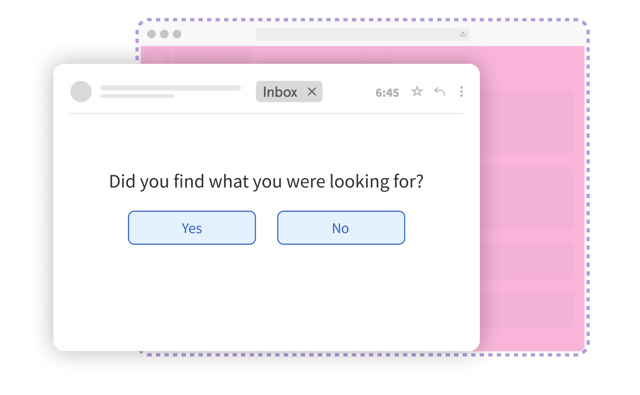
Examples
-
Have you used our product before?
-
Yes
-
No
-
-
Did you find the information helpful?
-
Yes
-
No
-
-
Would you recommend our service to others?
-
Yes
-
No
-
Tips from Experts
-
Use for Clarity: Yes/No questions are ideal when seeking clear and concise responses on specific topics without the need for detailed explanations.
-
Avoid Ambiguity: Formulate questions to be unambiguous, leaving no room for interpretation or confusion.
-
Limit Use: While useful in certain contexts, avoid overusing Yes/No questions, especially if more nuanced or detailed responses are needed.
-
Consider Neutral Responses: If applicable, include a neutral option (e.g., "Not sure" or "No opinion") for respondents who may be uncertain or indifferent.
-
Be Mindful of Bias: Be aware that the simplicity of Yes/No questions may introduce response bias or oversimplification of complex issues. Use them judiciously in your survey design.
15. Image choice questions
Image choice questions are a visual variation of multiple-choice questions where respondents select their answers by clicking on or indicating images rather than textual options. This format is particularly effective when surveying about visual preferences, branding, or product choices, as it allows for a more engaging and intuitive response process.
Examples
-
Select the logo that best represents our brand: [Images of different logos]
-
Choose the product variant you prefer based on the images provided: [Images of product options]
Tips from Experts
-
Ensure Image Clarity: Use high-quality and clear images to ensure that respondents can easily distinguish between options.
-
Maintain Relevance: Ensure that the images presented are directly related to the question and represent meaningful choices for respondents.
-
Optimize for Mobile: Consider the mobile responsiveness of your survey platform to ensure that respondents can interact with image choices seamlessly on various devices.
-
Include Descriptive Labels: Accompany each image with a brief, clear label to provide context and aid respondents in making informed choices.
How to Create Different Types of Survey Questions?
Creating effective survey questions involves careful consideration of the research objectives, clarity of communication, and alignment with the target audience. Here's a guide on how to create different types of survey questions.
-
Define Your Objectives - Clearly outline the goals of your survey to guide question creation. Determine where you need qualitative and quantitative data. Understanding the specific information you seek will help determine the most suitable question formats and choose the right mix of open-ended or closed-ended questions.
-
Choose the Right Question Format - Select the appropriate question format based on your objectives. Common formats include open-ended, closed-ended (multiple-choice, Yes/No, etc.), Likert scales, ranking, and matrix questions.
-
Mix Closed-Ended and Open-Ended Questions - Combine closed-ended questions for quantitative data with open-ended questions for qualitative depth. This mix provides a more comprehensive view of respondents' perspectives.
-
Tailor Questions to Your Audience and Objectives- Consider your target audience's characteristics and frame questions in a way that resonates with them. Language, cultural background, and familiarity with the topic are key factors to consider. Tailor your questions as per your target audience and the objectives you have decided.
-
Pilot Test Your Survey - Conduct a pilot test before the full survey launch to identify and address any issues with question-wording, response options, or overall survey flow. This ensures a smooth and effective data collection process.
Let’s see some best practices to follow while choosing the question types and creating survey questions.
Best Practices to Create Effective Survey Questions
Here are some best practices for utilizing various question types and creating effective survey questions.
-
Use Simple and Clear Language - Formulate questions using simple and clear language. Avoid jargon or complex terminology that might confuse respondents. Clarity is essential for accurate responses.
-
Avoid Double-Barreled Questions - Each question should focus on a single idea or concept. Avoid combining multiple thoughts within one question to prevent confusion and ensure accurate responses.
-
Provide Balanced Response Options - For closed-ended questions, ensure response options are balanced and cover the full range of potential answers. This avoids response bias and provides a more accurate representation.
-
Consider Question Order - Arrange questions in a logical sequence. Start with less sensitive or straightforward topics before progressing to more complex or personal inquiries to maintain respondent comfort.
-
Include a Mix of Question Types - Incorporate a variety of question types to gather both quantitative and qualitative data. Combine closed-ended questions for statistical analysis with open-ended questions for in-depth insights.
Ready to start sending your first survey?
So you have learnt about the various types of survey questions that you can use to create effective survey questions as per your survey requirements and the information that you want to obtain using those surveys. The best way to create effective surveys is by using a powerful survey software that allows you to use all these question types in your surveys.
Zonka Feedback is one such survey software that can serve the purpose. It is equipped with compatibility with 40+ question types and ready-to-use templates with various themes and advanced features like survey logic and question branching.
It also offers a free trial. Try Zonka Feedback for free for 14 days and harness the power of multiple question types to create effective surveys and collect valuable feedback and other information from your customers.

 MS Teams
MS Teams












